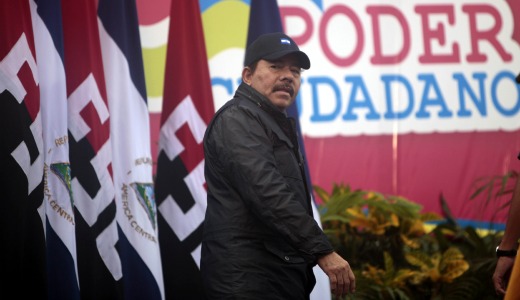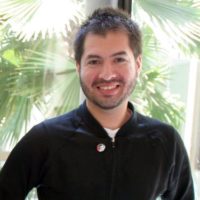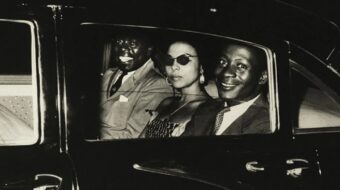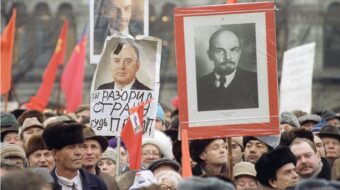
LOS ANGELES – Nicaragua is a small tropical country and although it’s the largest nation in Central America, it’s also the second poorest in the western hemisphere. Thirty-two years ago, a Marxist-led national liberation movement forever changed the history and political dynamics of Nicaragua.
Following the ideals of Nicaragua’s legendary revolutionary Augusto César Sandino and inspired by both Russian and Cuban revolutions, the people of Nicaragua fought and won a revolution over the repressive U.S.-backed Somoza dictatorship on July 19, 1979.
Recently at the Los Angeles Workers’ Center, the Sandinista National Liberation Front (FSLN) celebrated its 32nd anniversary of the revolution and the 50th anniversary of the founding of the guerilla movement-turned political party. Nearly 200 people attended the celebration.
Representatives of the FSLN and the Salvadoran Farabundo Martí National Liberation Front (FMLN) addressed the crowd including Francisco Mayorga, FSLN’s political secretary of Southern California.
Mayorga said he was honored to celebrate the group’s anniversaries – 50 years since the founding of the FSLN and the 32 years since the FSLN “took down one of the most perverse dictatorships in Latin America at that moment.”
Mayorga noted all the former guerillas in attendance and reflected on the armed struggle paying tribute to all those that fought in the revolution.
Augusto César Sandino led the first armed uprising against the U.S. military intervention in Nicaragua in the 1920s and 30s. He led battles against the U.S.-allied Anastacio Somoza García’s regime. Those struggles later inspired Nicaraguans to lead a second wave of revolution against the Somoza’s sons – Luis Somoza Debayle and Anastacio Somoza Debayle. Carlos Fonseca, a Marxist, and a small group of Nicaraguan socialists help found the FSLN in 1962.
Fonseca had traveled to Cuba and Russia in his early 20s and was heavily influenced by both socialist nations.
He once said, “It is not our job to discover the universal laws that lead to the transformation of a capitalist society into a society of free men and women; our modest role is to apply these laws, which have already been discovered, to the conditions of our own country,”
In 1976 the National Guard eventually killed Fonseca during combat. But on July 19, 1979 the Somoza dynasty was ultimately toppled.
In 1984, the FSLN called for elections and won.
During this time the Contra War had just started. The Contras, supported by the U.S., were remnants of the Nicaraguan National Guard. The Contras coupled with the U.S.’s economic blockade against the new socialist-leaning government, devastated Nicaragua.
Because of these factors-among others-the Sandinistas lost the elections in 1990 to the right-wing United National Opposition (UNO) led by Violeta Barrios de Chamorro.
After a 16-year Neoliberal rule that reversed several revolutionary government programs, Daniel Ortega and the FSLN won back the presidential seat in 2006. Prior to the 1979 revolution Nicaragua suffered more than 40 years of military right-wing rule.
Back at the Los Angeles Workers’ Center, Carlos J. Flores, youth secretary of the FSLN in Southern California, spoke in support of the Sandinistas in this year’s election.
Next Nov. 6 Nicaragua will hold presidential elections with its candidate and current president, Daniel Ortega, running on the FSLN ticket.
According to Flores current polls show FSLN ahead, just slightly over 50 percent.
“But,” Flores warns, “We cannot think that we have it made and rest on our laurels-
Because that’s what the right-wing wants.”
Flores recalls in 1990, similar polls said the FSLN was ahead but the revolutionaries ended up losing the elections.
“There has been 16 years of Neoliberal rule which pretty much messed up the country,” said Flores. “Venezuela and ALBA are helping Nicaragua. Cuba sends doctors. We send them our resources. It’s a mutual cooperation,” he added.
And it’s not just the poor people of Nicaragua that understand this, notes Flores. The right-wing forces have subtly admitted to the vast improvements the Sandinista government has brought to the country, he said.
“Right now-we’re in transition toward socialism. You can’t go from capitalism to socialism right away,” Flores said.
Augusto César Sandino, who after evading the U.S. marines in the mountains of his own country, once said, “Nicaragua shall not be the patrimony of imperialists. I will fight for my cause as long as my heart beats.”
And although Sandino’s heart has long since stopped beating, the movement he inspired toward a more free and equal society, where the public wealth of a nation is kept in the hands of workers that create it, lives on.
Photo: Nicaragua’s President Daniel Ortega looks on during an event marking the 32nd anniversary of the Sandinista’s withdrawal to Masaya in Managua, June 25. The withdrawal to Masaya was a tactical move by the Sandinistas that was critical in the overthrow of Anastasio Somoza’s dictatorship in 1979. (AP Photo/Esteban Felix)












Comments